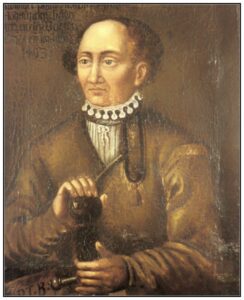 |
| Matthew Dobson. Source |
Matthew Dobson is remembered mainly for examining in 1775 a thirty-three-year-old man and completing his evaluation by tasting his blood and his urine. He found the serum was opaque, much resembling common cheese whey, but not as sweet as the urine. On heating the urine, he found a residual granulated white cake that broke easily between the fingers, smelled sweet like brown sugar, and tasted like it. He concluded that “saccharine matter” was being drawn off from the body by the kidneys “before it was perfectly assimilated” and that this accounted for the patient’s emaciation. He mentioned that other patients he had seen lost weight quite quickly and died within five weeks rather than suffer from a chronic complaint.
Born in Yorkshire and educated in Glasgow, Matthew Dobson obtained his medical degree in Edinburgh in 1756 on submitting a dissertation on menstruation. During the Napoleonic Wars, he was a surgeon in the British Army. Later, he went into private practice in Liverpool, joined the staff of the local infirmary, was appointed full physician in 1770, and worked there for about a decade.
He followed the career trajectory of most other prominent physicians of his time. They had a classical education, learned Greek and Latin, and also carried out research—to help their patients, their practice, sometimes as a hobby, or because they were expected to do so as prominent physicians of their city. Conceivably the occasional ones may have even been aware of the uselessness of some of their treatments and felt that their life was a hoax as they walked around sumptuously clad and adorned with gold chains?
Be that as it may, Matthew Dobson studied in 1775 the effects of exposing certain diseases to heat. He described a “curious experiment” in which he and a few others spent several minutes in a small “sweating room” of nearly nine cubic feet heated to 224 degrees Fahrenheit and recorded the effects on their pulse and general condition. In a letter to John Fothergill, Dobson he described how the pulse rate went up in some, but none suffered ill-effects. An egg taken out of its shell promptly coagulated. Beeswax melted on mere contact with the air. Nothing much else came of that particular project.
In a later study, in 1779, Dobson investigated the uses of “pneumatic therapy” and the effects of exposure to the newly isolated gases such as carbon dioxide (“fixed air”). Like his contemporary Beddoes near Bristol, he tried this approach to cure scurvy, diphtheria, scarlet fever, and lung diseases. He tried using mineral waters to relieve respiratory ailments and attempted “pneumatic therapy” to loosen hardened material in the urinary tract. He published his major work, A Medical Commentary on Fixed Air, in 1779 in London. He also treated certain patients with large doses of mercury.
Dobson established the Liverpool Academy of Art, was elected to the Royal Society in 1778, and later became head of the Liverpool medical library. He was the doctor and confidant of Hester Thrale, the friend of Samuel Johnson. In 1780, he retired to Bath, where he died some four years later.
Further reading
- Editorial: Matthew Dobson (1735?-1784). Clinical investigator of diabetes mellitus. JAMA Sept 2, 1968:205:698.
GEORGE DUNEA, MD, Editor-in-Chief
Spring 2023 | Sections | Physicians of Note

Leave a Reply